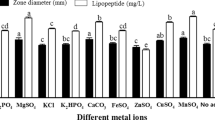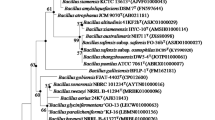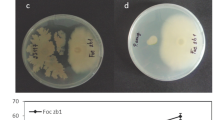Abstract
Two strains of Erwinia herbicola effective in the biocontrol of E. amylovora, the etiological agent of fire blight, were screened for proferrioxamine siderophores by on-line liquid chromatography-electrospray mass spectrometry (LC-MS). Type strains of E. herbicola and Pantoea species were included in this study for taxonomic comparisons. Proferrioxamine profiles similar to that previously described for E. amylovora, including tri- and tetrameric hydroxamates and diaminopropane-containing proferrioxamines, were observed for P. agglomerans, but not for other E. herbicola-like species. Biocontrol activity was not correlated with proferrioxamine synthesis. The results of this study are consistent with the notion that some, but not all, biocontrol strains may inhibit E. amylovora via competition for iron. Further studies into the link between biocontrol of fire blight and siderophores are thus warranted. This study also revealed limitations of standard nutrient utilization and fatty acid profile analyses for the differentiation of P. agglomerans, P. dispersa and other E. herbicola-like species from each other. Given these limitations, LC-MS may become a much needed additional diagnostic tool for the identification of E. herbicola-like strains at the species level.
Similar content being viewed by others
References
Berner I, Winkelmann G. 1990 Ferrioxamine transport mutants and the identification of the ferrioxamine receptor protein (FoxA) in Erwinia herbicola (Enterobacter agglomerans). Biol Met 2, 197–202.
Berner I, Konetschny RS, Jung G, Winkelmann G. 1988 Characterization of ferrioxamine E as the principal siderophore of Erwinia herbicola (Enterobacter agglomerans). Biol Met 1, 51–56.
Berner I, Greiner M, Metzger J, Jung G, Winkelmann G, 1991 Identification of enterobactin and linear dihy-droxybenzoylserine compounds by HPLC and ion spray mass spectrometry (LC/MS and MS/MS). BioMetal 4, 113–118.
Burr TJ, Norelli JL, Reid CL, et al. 1993 Streptomycin-resistant bacteria associated with fire blight infections. Plant Dis 77, 63–66.
Chiou CS, Jones AL. 1993 Nucleotide sequence analysis of a transposon (Tn5393) carrying streptomycin resistance genes in Erwinia amylovora and other gramnegative bacteria. J Bacteriol 175, 732–740.
Costa JM, Loper JE. 1994 Characterization of siderophore production by the biological control agent Enterobacter cloacae. Mol Plant-Microb Interact 7, 440–448.
El-Goorani MA, Hassanein FM, Shoeih AA. 1992 Antibacterial and antifungal spectra of antibiotics produced by different strains of Erwinia herbicola (=Pantoea agglomerans). J Phytopathol 136, 335–339.
Feistner GJ. 1994 Metabolism of polyamines and basic amino acids in Erwinia amylovora: application of liquid chromatography/electrospray mass spectrometry to proferrioxamine precursor feeding and inhibition studies. Biol Mass Spectrom 23, 793–803.
Feistner GJ. 1995a Proferrioxamine synthesis in Erwinia amylovora in response to precursor and hydroxylysine feeding: application of liquid chromatography-electro-spray mass spectrometry to metabolic profiling. Bio Metals 8, 318–327.
Feistner GJ. 1995b Suggestion for a new, semirational nomenclature for the free chelators of ferrioxamines. Bio Metals 8, 193–196.
Feistner GJ. 1995c Liquid chromatography-electrospray tandem mass spectrometry of dansylated polyamines and basic amino acids. J Mass Spectrom 30, 1546–1552.
Feistner GJ, Gabrik AH, Beer SV. 1993a Application of capillary liquid chromatography-electrospray mass spectrometry to identify major siderophorcs of Erwinia amylovora as proferrioxamines and their potential role in virulence. In: Kado CI, Crosa JH, eds. in Molecular Mechanisms of Bacterial Virulence. Dordrecht: Kluwer; 429–444.
Feistner GJ, Stahl DC, Gabrik AH. 1993b Proferri-oxamine siderophores of Erwinia amylovora. A capillary liquid chromatography-electrospray tandem mass spectrometric study. Org Mass Spectrom 28, 163–175.
Gavini F, Mergaert J, Beji A, et al. 1989 Transfer of Enterobacter agglomerans Beijerinck 1888 Ewing and Fife 1972 to Pantoea new genus as Pantoea agglomerans new combination and description of Pantoea dispersa. Int J Syst Bacteriol 39, 337–345.
Ishimaru CA, Loper JE. 1993 Biochemical and genetic analysis of siderophores produced by plant-associated Pseudomonas and Erwinia species. In: Barton LL, Hemming BC, eds. Iron Chelation in Plants and Soil Microorganisms. New York: Academic Press: 27–73.
Ishimaru CA, Klos EJ, Brubaker RR. 1988 Multiple antibiotic production by Erwinia herbicola. Phyto-pathology 78, 746–750.
Johnson KB, Stockwell VO, McLaughlin RJ, et al. 1993 Effect of antagonistic bacteria on establishment of honey bee-dispersed Erwinia amylovora in pear blossoms and on fire blight control. Phytopathology 83, 995–1002.
Kokošková B. 1991 Antagonism between the Erwinia herbicola and Erwinia amylovora bacteria (In Czech). Sbornik Uvtiz (Ustav Vedeckotechnickych informaci pro Zemedelstvi) Ochrana Rostlin 27, 239–248.
Kokošková B. 1996 Effectiveness of Erwinia herbicola strains and chemicals to blossom fire blight control. In: Proc. Conf. on ‘75 Years of Phytopathological and Resistance Research at Aschersleben’, in press.
Lindh E, Kjaeldgaard P, Frederiksen W, Ursing J. 1991 Phenotypical properties of Enterobacter agglomerans (Pantoea agglomerans) from human, animal and plant sources. APMIS 99, 347–352.
Loper JE, Ishimaru CA. 1991 Factors influencing siderophore-mediated biocontrol activity of rhizosphere Pseudomonas spp. In: Keister DL, Cregan PB, eds. The Rhizosphere and Plant Growth. Netherlands: Kluwer; 253–261.
McManus PS, Jones AL. 1994 Epidemiology and genetic analysis of streptomycin-resistant Erwinia amylovora from Michigan and evaluation of oxytetracycline for control. Phytopathology 84, 627–633.
Meng SY, Bennett GN. 1992 Nucleotide sequence of the Escherichia coli cad operon: a system for neutralization of low extracellular pH. J Bacteriol 174, 2659–2669.
Obrien IEW. 1993 Comparison of malus infection by the pathogen Erwinia amylovora and colonization by the saprophyte Erwinia herbicola by electron microscopy. NZ J Crop Horticult Sci 21, 33–38.
Schaad NW 1988. Laboratory Guide for Identification of Plant Pathogenic Bacteria. 2nd ed. St. Paul. MN: APS Press.
Schupp T, Waldmeier U, Divers M. 1987 Biosynthesis of desferrioxamine B in Streptomyces pilus: evidence for the involvement of lysine decarboxylase. FEMS Microbiol Lett 42, 135–139.
Vanneste JL, Yu J, Beer SV. 1992 Role of antibiotic production by Erwinia herbicola Eh252 in biological control of Erwinia amylovora. J Bacteriol 174, 2785–2796.
Wells JM, van der Zwet T, Butterfield JE. 1994 Differentiation of Erwinia species in the ‘Herbicola’ group by class analysis of cellular fatty acids. J Phytopathol 140. 39–48.
Wilson M, Epton HAS, Sigee DC. 1990 Biological control of fire blight of hawthorn (Crategus monogyna) with Erwinia herbicola under protected conditions. Plant Pathol 39, 301–308.
Wodzinski RS, Paulin JP. 1994 Frequency and diversity of antibiotic production by putative Erwinia herbicola strains. J Appl Bacteriol 76, 603–607.
Wodzinski RS, Umholtz TE, Rundle JR, Beer SV. 1994 Mechanisms of inhibition of Erwinia amylovora by Erwinia herbicola in vitro and in vivo. J Appl Bacteriol 76, 22–29.
Author information
Authors and Affiliations
Rights and permissions
About this article
Cite this article
Feistner, G.J., Ishimaru, C. Proferrioxamine profiles of Erwinia herbicola and related bacteria. Biometals 9, 337–344 (1996). https://doi.org/10.1007/BF00140602
Received:
Accepted:
Issue Date:
DOI: https://doi.org/10.1007/BF00140602




